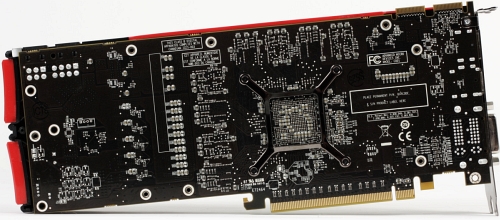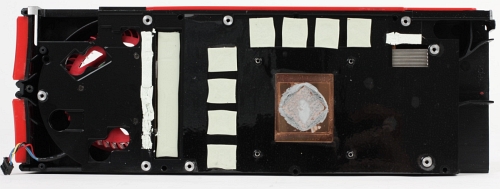Index

Review: It's DirectX 11 time
Today, we give you Sapphire HD 5870 graphics card which apart from good performance, has something else to bring to the table - DirectX 11. This card's ticker is called Cypress, and it belongs to AMD's Evergreen family of products. With this card, AMD has opened the doors to DirectX 11, Windows 7 and games which will be played with this lethal combination (which are currently seriously scarce).
The new graphics card runs at 850MHz core and 1200MHz for the memory (4800MHz GDDR5 effectively). The Cypress GPU features a complex architecture with 2.15 billion transistors, whereas the HD 4890 has 959 million. Thanks to the 40nm process, the die on the new card measures 338mm, which isn't much larger than the 282mm old one. The shaders got a boost from 800 (HD4890) to 1600 (HD 5870) thanks to a significant number of added transistors.
The HD 5870 features 32 ROP units, double the amount found on the HD 4870. Texture units have been doubled as well and the HD 5870 features 80, and the computing power jumped from 1.2 TFLOPs to 2.72 TFLOPs as well.
So, Cypress is a high-end DirectX 11 single-GPU graphics card, but as we've come to expect from graphics companies, dual-GPU versions of the HD 5870 codenamed Hemlock or HD 5870 X2 will follow. Although Radeon HD 5850 launched as well, more samples of this slightly slower DX11 card will be available in about one week.All the following DX11 card are in Evergreen family of products, and the codenames are as follows: Cedar, Redwood, Juniper, Cypress and Hemlock (ordered from the bottom to the top).
ATI’s HD 5870 1GB version comes with GDDR5 memory, DVI, HDMI and DisplayPort, and is priced at around $399 or €320 (VAT incl.) in EU. The 2GB version of Cypress and Eyefinity version will end up pricier, but they’re definitely good deals compared to Nvidia’s GT200 or Radeon 48x0 cards.
Juniper cards are expected in this quarter and should be priced below $199 whereas Cedar and Redwood, which should be out by the end of 2009, should bring DX11 support to the sub-$100 segment. The only problem for AMD is the fact that there are no DirectX 11 games on the market currently, which would’ve boosted Evergreen sales significantly. Of course, you’ll find many musle-hungry DX9, DX10 and DX10.1 titles that can put Cypress to good use, but investing a reasonable amount of cash for a bright DX11 future isn’t a bad deal at all.
AMD didn’t only focus its efforts towards doubling the performance, but paid attention to power consumption as well, so the new card doesn’t consume much more than its predecessor despite the performance increase and and doubled components. The HD 5870’s maximum consumption is 188W, whereas the HD 4870 consumed up to 160W. AMD finally addressed the idle consumption, and the company claims that HD 5870 requires only 27W.
Those who have been following this card know that it comes with Eyefinity technology, which allows for more than two monitors on one card. The HD 5870 features two dual-link DVI outs, one HDMI and one Display port. So technically, you can use a large 7680x3200 resolution split across monitors. The HD 5870 Eyefinity edition will have six DisplayPort outs but the real treat is a mere thought of quad Crossfire and support for up to 24 monitors.
The following photo shows Sapphire HD 5870 card with large dual slot cooling.

Sapphire uses reference cooling and the only difference between this and reference cards is Sapphire's sticker. The card is 28cm which almost screams high end, as it's about 1cm longer than the HD 4870X2 card.
The cooler covers the front of the card, and the back of the card is hidden by the metal plate holding the cooling. The card looks really nice, and the red camp's efforts are obvious.

We really liked the combination of black matte plastic and no rough edges. As you can see, the openings reserved for ventilation look really nice, as well as the ATI-engraved top which will be visible even when the card is in place.
The following picture shows the power connectors - the card requires two 6-pin cables to run.
On the rear of the card you’ll find a metal plate for which we can’t say with certainty whether it helps in cooling the card, but it shields the PCB from potential damage and sure looks good. The following picture shows the graphics core. The Crossfire connectors kept their standard position and we already mentioned that 4 Cypress Eyefinity cards will allow for an impressive number of 24 monitors.
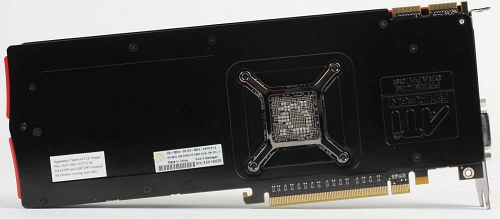
You won’t find memory modules underneath the plate as all 8 modules are placed on the GPU side of the PCB. The cooling is firmly fixed in its place with screws going through the PCB and into the metal plate.
The cooler stretches the entire length of the PCB and it's mostly made of copper. As you can see from the thermal paste prints, it leans on the memory and many other power components.
The combination of the heavy copper base, heatpipe technology and a large dissipation surface area on the aluminum fins helps the cooler to keep the card at about 80°C during operations. In extreme FurMark scenarios the card can hit up to 86°C, but while gaming it never exceeds 80°C.
Note however that we used the large CoolerMaster ATCS 840 case with a great airflow, but smaller and more cramped cases might result in higher temperatures. Idle temperatures were around 39°C. The fan does a good job and while it's not too loud, we'd still have liked if it could be quieter. Note that idle operation results in pretty low noise levels.
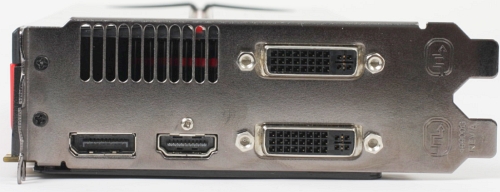
The I/O panel features two dual-link DVI outs as well as one HDMI and one DisplayPort out. This card will run up to three monitors at a time.
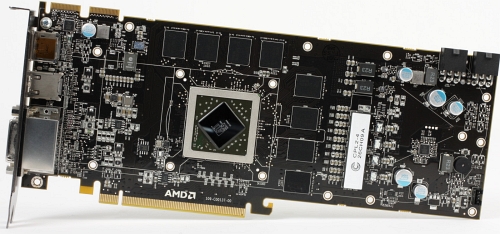
AMD did a good job on the power management circuitry and used two Voltera VT1165 MF Voltage controllers which can be controlled from software. The card draws power from two 6-pin power connectors.
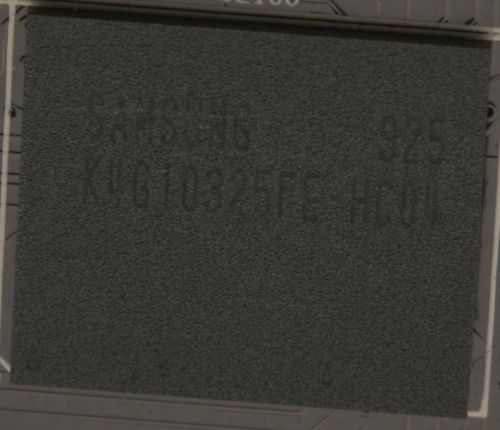
The card uses new Samsung’s K4G10325FE-HC04 rated at 1250MHz (5000MHz GDDR5 effectively).
AMD's new Cypress GPU has 2154 million transistors and is made in 40nm.
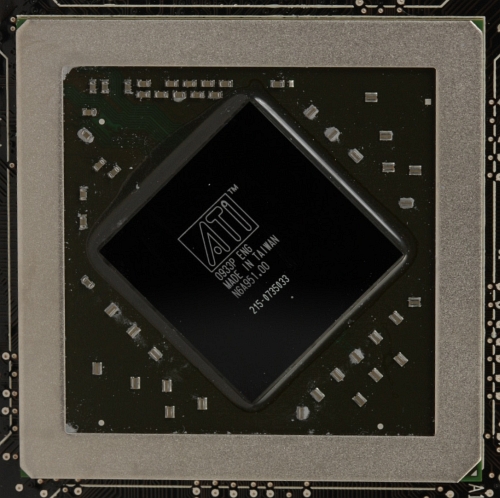
If you decide on purchasing Sapphire's HD 5870, you'll get not one but two games - Battlestations Pacific and the coupon for Dirt 2 - which should shows some of the tricks DX11 will bring.
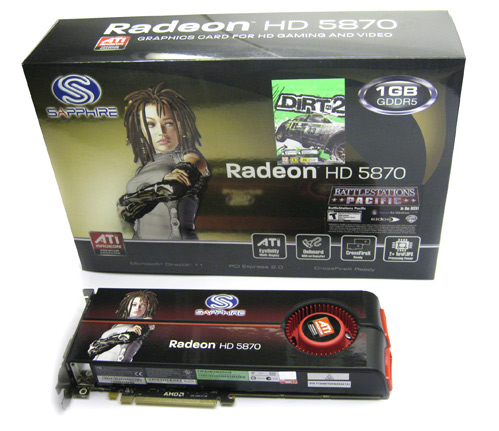
Futuremark
Futuremark tests act as a prelude for gaming tests, where HD 5870 makes the currently fastest AMD card, Radeon HD 4870 X2 work really hard. Nvidia's ace, the GTX 295 is undefeated both in Futuremark tests as well as gaming ones, but the single-GPU GTX 285 is evidently slower than Radeon HD 5870.




Left 4 Dead
Sapphire HD 5870 shows that the Cypress GPU with its 1600 shaders packs a mean punch. It beats AMD's top card, the HD 4870 X2 at every single resolutions, and holds its own nicely versus the dual-GPU GTX 295. We must say that 87fps at 2560x1600 with antialiasing is an impressive result. The same resolution with antialiasing on sees the HD 5870 only 4fps slower than the GTX 295. Geforce GTX 285 lags behind by sometimes more than 30%, and the performance difference is more evident at higher resolutions.






HAWX
Thanks to DirectX 10.1 instruction support, ATI Radeon clearly has an upper hand, of course if DX 10.1 option is turned on. Unfortunately, although Sapphire HD 5870 is a DX11 card, there are currently no games made for this new API. On the other hand, Cypress GPU will surely make DX11 gaming a treat, and 59fps at 2560x1600 stands as a testament to that.






World in Conflict
World in Conflict shows that HD 5870 is still not ready to take the "fastest card" title, and although Sapphire's HD 5870 produced playable framerates at all the tested resolutions, the GTX 295 turned out to be invincible in this game. Of course, we're yet to see whether the future dual-GPU version of this card, codenamed Hemlock will change that.






Far Cry 2
At 2560x1600 and antialiasing on, the Sapphire HD 5870 spews out 46fps. Although the HD 5870 loses to the GTX 295 by 26%, it manages to beat the dual-GPU HD 4870 X2 at a couple of resolutions.






Batman Arkham Asylum
This is a new game which takes gaming to another level - the graphics looks simply stunning and it makes use of Nvidia's Physx technology. Unfortunately, we had no time to include this game in the results. Sapphire's HD 5870 allowed for smooth gaming, and we played with it for a few hours changing the settings and resolutions. We think it will be interesting to see how AMD copes with Nvidia's new favorite game, so we will post some results soon.
Conclusion
Sapphire Radeon HD 5870 1GB GDDR5 is a card we'd wish for ourselves. The Cypress GPU's performance is already excellent, without its potential being utilized to the max, which makes it a potential blockbuster. Unfortunately, the HD 5870 won't really shine until the first batch of DirectX 11 games and Windows 7 are here. On the other hand, buying this card means you're investing in the future, and this card is definitely a tough nut to crack for almost any card in current games, not to mention future titles.
It comes with 1GB of speedy GDDR5 memory at 1200MHz (4800MHz effectively) and the Cypress core at 850MHz. Sapphire HD 5870 shows that it has what it takes to handle anything you might throw its way, and although the dual-GPU HD 4870 X2 has an upper hand in many tests, the HD 5870 is always close. So pick your favorite feature that makes this card worthwhile - the fastest single GPU card, DX11 capable, significant decrease in consumption, more quiet operation, and the list goes on.
On the other hand, the card is a bit pricey but the upcoming HD 5850 will surely change that. Besides, you can always wait for the price drops. Be it as it may, this card is the fastest single-GPU offering on the market, and currently the only DX11 supporting card, and if you're looking for any of these two things then Sapphire HD 5870 is not only the right, but only choice you currently have.



